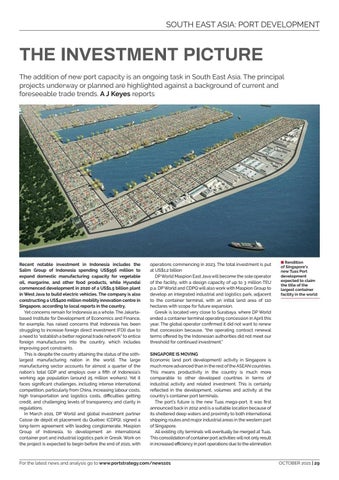SOUTH EAST ASIA: PORT DEVELOPMENT
THE INVESTMENT PICTURE The addition of new port capacity is an ongoing task in South East Asia. The principal projects underway or planned are highlighted against a background of current and foreseeable trade trends. A J Keyes reports
Recent notable investment in Indonesia includes the Salim Group of Indonesia spending US$956 million to expand domestic manufacturing capacity for vegetable oil, margarine, and other food products, while Hyundai commenced development in 2020 of a US$1.5 billion plant in West Java to build electric vehicles. The company is also constructing a US$400 million mobility innovation centre in Singapore, according to local reports in the country. Yet concerns remain for Indonesia as a whole. The Jakartabased Institute for Development of Economics and Finance, for example, has raised concerns that Indonesia has been struggling to increase foreign direct investment (FDI) due to a need to “establish a better regional trade network” to entice foreign manufacturers into the country, which includes improving port constraints. This is despite the country attaining the status of the 10thlargest manufacturing nation in the world. The large manufacturing sector accounts for almost a quarter of the nation’s total GDP and employs over a fifth of Indonesia’s working age population (around 25 million workers). Yet it faces significant challenges, including intense international competition, particularly from China, increasing labour costs, high transportation and logistics costs, difficulties getting credit, and challenging levels of transparency and clarity in regulations. In March 2021, DP World and global investment partner Caisse de dépôt et placement du Québec (CDPQ), signed a long-term agreement with leading conglomerate, Maspion Group of Indonesia, to development an international container port and industrial logistics park in Gresik. Work on the project is expected to begin before the end of 2021, with
operations commencing in 2023. The total investment is put at US$1.2 billion DP World Maspion East Java will become the sole operator of the facility, with a design capacity of up to 3 million TEU p.a. DP World and CDPQ will also work with Maspion Group to develop an integrated industrial and logistics park, adjacent to the container terminal, with an initial land area of 110 hectares with scope for future expansion. Gresik is located very close to Surabaya, where DP World ended a container terminal operating concession in April this year. The global operator confirmed it did not want to renew that concession because, “the operating contract renewal terms offered by the Indonesian authorities did not meet our threshold for continued investment.”
8 Rendition of Singapore’s new Tuas Port development expected to claim the title of the largest container facility in the world
SINGAPORE IS MOVING Economic (and port development) activity in Singapore is much more advanced than in the rest of the ASEAN countries. This means productivity in the country is much more comparable to other developed countries in terms of industrial activity and related investment. This is certainly reflected in the development, volumes and activity at the country’s container port terminals. The port’s future is the new Tuas mega-port. It was first announced back in 2012 and is a suitable location because of its sheltered deep waters and proximity to both international shipping routes and major industrial areas in the western part of Singapore. All existing city terminals will eventually be merged at Tuas. This consolidation of container port activities will not only result in increased efficiency in port operations due to the elimination
For the latest news and analysis go to www.portstrategy.com/news101
OCTOBER 2021 | 29











